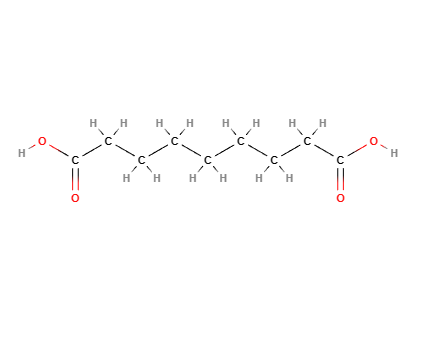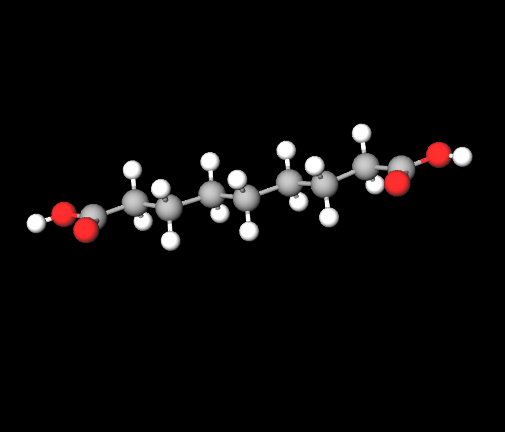| "Descrizione" by admin (19549 pt) | 2024-Apr-19 09:07 |
Azelaic acid is an organic compound naturally found in many grains such as wheat, rye, and barley. It is known for its antibacterial and anti-inflammatory properties and is commonly used in the treatment of dermatological conditions (1) such as acne and rosacea.
The name describes the structure of the molecule:
- Azelaic comes from "azele", which is derived from the Greek word for "refined", indicating that azelaic acid is a nine-carbon dicarboxylic acid (C9).
- acid refers to a chemical substance that can release hydrogen ions and has a pH less than 7. Acids are commonly used in chemistry and medicine for their reactive properties and therapeutic benefits.
Chemical Industrial Synthesis Process
- Raw material selection. The production of azelaic acid begins with the selection of oleic acid, a fatty acid found in many vegetable oils.
- Oxidation. Oleic acid is subjected to an ozonolytic oxidation process, where ozone is used to cleave the double bonds in oleic acid, forming nonanedioic acid (azelaic acid) and other by-products.
- Purification. After oxidation, the reactive mixture is treated to remove impurities and isolate azelaic acid. This may include steps such as vacuum distillation and crystallization.
- Crystallization. The purified azelaic acid is further refined through crystallization, thus enhancing the purity and quality of the final product.
- Drying. The crystallized product is then dried to eliminate any traces of solvents or moisture.
- Quality control. Before shipment, samples of azelaic acid are tested to ensure they meet the required purity and quality specifications for industrial applications.
What it is used for and where
Azelaic acid is a natural compound found in wheat, rye, and barley, and is commonly used in dermatology for its antibacterial and anti-inflammatory properties. Azelaic acid works by inhibiting the growth of bacteria that cause acne and reducing the production of keratin, a factor that can block pores. It is also used to treat hyperpigmentation, as it has the ability to inhibit the activity of tyrosinase, an enzyme involved in melanin production. This makes it effective in improving skin tone and reducing dark spots.
Cosmetics - INCI Functions
- Buffering agent. It is an iingredient that can bring an alkaline or acid solution to a certain pH level and prevent it from changing, in practice a pH stabiliser that can effectively resist instability and pH change.
- Fragrance. It plays a very important role in the formulation of cosmetic products as it provides the possibility of enhancing, masking or adding fragrance to the final product, increasing its marketability. It is able to create a perceptible pleasant odour, masking a bad smell. The consumer always expects to find a pleasant or distinctive scent in a cosmetic product.
Main uses and benefits of azelaic acid
Acne Treatment. Azelaic acid helps reduce inflammation and has antibacterial properties that make it effective in treating mild to moderate acne.
Pigmentation Reduction. It is known for its ability to lighten skin pigmentation, including that caused by melasma or post-inflammatory hyperpigmentation, improving skin tone uniformity.
Anti-inflammatory Properties. It offers anti-inflammatory benefits that help reduce redness and irritation associated with conditions like rosacea.
Prevents Clogged Follicles. It helps prevent the clogging of pores and the formation of comedones, contributing to keeping the skin clear.
Comedolytic and Keratolytic. Azelaic acid accelerates skin cell renewal, helping to remove dead cells and prevent the buildup of cells that can lead to blemishes.
Safety
It is generally well tolerated and can be used on all skin types, including sensitive skin.
 |  |
Molecular Formula C9H16O4
Molecular Weight 188.22 g/mol
CAS 123-99-9
UNII F2VW3D43YT
EC Number 204-669-1
DTXSID8021640
Synonyms:
Azelex
Finacea
monosodium azelate
nonanedioic acid
References_____________________________________________________________________
(1) Searle T, Ali FR, Al-Niaimi F. The versatility of azelaic acid in dermatology. J Dermatolog Treat. 2022 Mar;33(2):722-732. doi: 10.1080/09546634.2020.1800579.
Abstract. Azelaic acid has numerous pharmacological uses in dermatology. Its anti-inflammatory and anti-oxidant properties are thought to correlate with its efficacy in papulopustular rosacea and acne vulgaris, amongst other cutaneous conditions. We conducted a review of the literature on the use of azelaic acid in dermatology using key terms 'acne', 'azelaic acid', 'dermatology', 'melasma', 'rosacea', searching databases such as MEDLINE, EMBASE and PubMed. Only articles in English were chosen. The level of evidence was evaluated and selected accordingly listing the studies with the highest level of evidence first using the Oxford Center of Evidence-Based Medicine 2011 guidance.This review found the strongest evidence supporting the use of azelaic acid in rosacea, followed by its use off-label in melasma followed by acne vulgaris. Weaker evidence is currently available to support the use of azelaic acid in several other conditions such as hidradenitis suppurativa, keratosis pilaris and male androgenic alopecia.Azelaic acid, as a monotherapy or in combination, could be an effective first-line or alternative treatment, which is well-tolerated and safe for a range of dermatological conditions.
(2) Chilicka K, Rogowska AM, Szyguła R, Dzieńdziora-Urbińska I, Taradaj J. A comparison of the effectiveness of azelaic and pyruvic acid peels in the treatment of female adult acne: a randomized controlled trial. Sci Rep. 2020 Jul 28;10(1):12612. doi: 10.1038/s41598-020-69530-w. PMID: 32724156; PMCID: PMC7387545.
Abstract. Chemical peels are widely used as therapeutic agents in dermatology and cosmetology. This study aims to explore the differences in the effectiveness of azelaic and pyruvic acid peels in the treatment of acne vulgaris. Eligibility criteria for participants were: female gender, 18-25 years of age, no dermatological treatment within the last 12 months and mild to moderate papulopustular acne. We treated 120 young women (with a mean age of 22 years old) with six peeling sessions at 2-week intervals. In the parallel clinical study design, one randomized group (n = 60, 50%) was treated using azelaic acid (AA), whereas the second group participated in pyruvic acid (PA) sessions. We evaluated the patients clinically twice (before and after treatment), using the Scale of Hellegren-Vincent Severity Symptoms to assess the acne diagnosis, and the Nati Analyzer to estimate the skin properties (oily skin, desquamation, porosity, and moisture). The clinical evaluation of the patients demonstrated a significant reduction of acne severity symptoms in both the AA and PA groups, after the peeling sessions. An effect was also found in terms of decreasing desquamation and the oiliness of the skin. PA showed a more significant reduction of greasy skin than AA. In conclusion, after the six peeling sessions using AA and PA, all patients showed better skin parameters in term of reduced oiliness and desquamation. Both AA and PA peelings are a safe and efficient treatment for mild acne, however, during the selection of one of the two acids, side effects, skin properties, and patients' preferences should be taken into account. This study was registered in the ISRCTN registry (registration number ISRCTN79716614, 17/01/2020).
(3) Searle T, Al-Niaimi F, Ali FR. Rosacea. Br J Hosp Med (Lond). 2021 Feb 2;82(2):1-8. doi: 10.12968/hmed.2020.0417.
Abstract. Rosacea is a common cutaneous condition affecting predominantly the face. It is historically characterised into four subtypes: erythematotelangiectatic, papulopustular, phymatous and ocular rosacea. This article describes the pathophysiology, clinical features and current treatment options for rosacea, and discusses updated diagnostic criteria. General guidance is required on the need to avoid possible triggers including dietary and environmental triggers. The strongest evidence supports the use of 0.75% metronidazole, topical azelaic acid or topical ivermectin for inflammatory rosacea. Erythema should be treated with brimonidine tartrate gel, oral medication such as beta blockers or vascular laser and light-based therapy. Oral doxycycline 40 mg modified release can be used as monotherapy or in combination with other treatments for recalcitrant disease. Further understanding of the pathogenesis of rosacea could allow identification and targeted avoidance of triggers and the development of new treatment modalities.
(4) Nazzaro-Porro M, Passi S, Picardo M, Breathnach AS, Zina G. Azelaic acid in the treatment of acne. G Ital Dermatol Venereol. 1989 Apr;124(4):175-84.
Abstract. This review is an update of the literature accumulated over the past 6 years following the original observation that topically applied azelaic acid, a non-toxic C9 dicarboxylic acid, has a beneficial therapeutic effect on acne vulgaris. These studies have shown that azelaic acid has a modulating influence on the process of keratinization, and that it acts as a keratolytic and anti-comedogenic agent. There is evidence that it inhibits mitochondrial and microsomal oxido-reductases, including 5-alpha-reductase, and that it may interfere with the process of sebogenesis. It has a spectrum of antimicrobial activity, both in vitro and in vivo, against aerobic microorganisms and is effective against the anaerobic Propionibacterium acnes. Extensive multi-centre clinical trials have established that topical azelaic acid (a 20% cream) is an effective treatment for all types of acne. It compares well with other agents, such as topical tretinoin or benzoyl-peroxide, or oral tetracycline. It is non-irritant, and does not give rise to allergic or photo-toxic reactions. Its use is not associated with teratogenicity, possible endocrine unbalance, or the disadvantages of antibiotic treatment. It can be applied for long periods, in recurrences, and as maintenance "spot" therapy against individual lesions.
| Evaluate |

